How to Achieve Business Adaptability With Adaptive Strategy Execution

What to read next:

What is business adaptability?
Before we begin, let's quickly define adaptability in business.
Business adaptability refers to a company’s ability to quickly respond to market changes, trends, industry shifts, economic disruptions, and other business challenges by adjusting operations to fit the new normal. This requires businesses to hone a specific set of skills, including:
- Agility : Rapidly reacting to changes in the market environment while keeping long-term goals in mind
- Innovation : Continuously building on top of competitive advantages to reach new heights of innovation
- Organizational transparency : Ongoing visibility into strategic priorities and decision-making processes
- Flexible resource deployment : Aptly relaying information and resources when necessary
- Value-driven collaboration : Relevant stakeholders collaborating to drive favorable results
Why is adaptive strategy execution important in business?
To understand why adaptability is important in business, all we need to do is take a quick glance at how the market environment evolved over the past few decades. The increasing pace, severity, and complexity of competitive and environmental challenges are never-ending have been never-ending, making business adaptability a must-have trait in organizations.
Forces such as globalization, technology, and big data are severely impacting how businesses function, while additional market jolts create turbulent business environments. In the past twenty years alone, we’ve experienced:
- The dot-com bubble of 2000
- The financial crisis of 2008
- The COVID-19 pandemic of 2020
With global business challenges occurring more often than we’d like, business adaptability must be tightly embedded within organizations, allowing them to align with industry shifts and remain relevant. Without adaptability in business:
- Decision-making takes weeks instead of minutes
- Employees focus on personal directives instead of company objectives
- Teams are misaligned and create duplicative or conflicting work
A new operational approach to business adaptability
To be successful amidst such large-scale challenges, organizations must leverage a comprehensive business adaptability framework. This involves a novel take on strategy execution — one adaptable enough to maximize engagement , productivity, and coordination whilst fending against obstacles.
“It is not the strongest of the species that survives, not the most intelligent that survives. It is the one that is the most adaptable to change.” - Charles Darwin
This modern business adaptability framework involves establishing agility using adaptive strategy execution. Adaptive strategy execution is a sure-fire way of encouraging flexibility, close communication, and routine operational assessments, ensuring ongoing alignment with internal and external changes.
Before looking at how you can embed this business adaptability framework into your organization, let’s take a closer look at two of its core concepts: the agile framework and adaptive strategy execution.
Understanding agile
The agile methodology is a product management approach initially created for software development projects. It involves a collaborative, iterative, and feedback-driven process to streamline processes, align employees, and improve products continuously.
While agile is now widely adopted by worldwide enterprises such as Apple, IBM, and Google, it didn’t happen overnight. Rather, it rose to success in three distinctive waves of adoption.
- First wave : Agile's growth in individual development teams in the 2000s
- Second wave : Agile at scale in product development and IT in the 2010s
- Third wave : Business agility deployed throughout the modern-day enterprise
Learn more about Agile in full detail

Nowadays, enterprise agility is hailed as a critical driver of innovation, efficiency, and customer engagement. It enables organizations to respond to market changes in a quick, value-focused manner by bringing decision-making closer to customers.
Given the importance of agility in navigating unstable environments for ensuring adaptability in business, your organization must proactively incorporate agility into your business processes. How can you go about doing this holistically?
The fundamentals of adaptive strategy execution
While agility is paramount to adaptability in business, it’s insufficient for creating maximum organizational efficiency. For long-term business adaptability, you must use agile as a steppingstone to a more all-encompassing approach: adaptive strategy execution.
What is strategy execution?
Understanding adaptive strategy execution requires you to first grasp the basics of strategy execution.
Strategy execution is all about ingraining high-level strategic vision into practical, day-to-day execution. It involves creating a plan for your goals and taking actionable steps toward achieving these using available resources.
A well-thought-out strategy execution process entails four steps :
- Planning a cohesive business strategy at the corporate, business, and functional levels
- Aligning individuals across the organization to clearly defined goals
- Executing and managing your strategy at scale
- Assessing and adapting your strategy in line with market changes
Making strategy execution adaptive
Adding the “adaptive” component to strategy execution is achieved through the Modern Operating Model. This model focuses on continuous flexibility, alignment, agility, and cross-functional accessibility using key performance indicators (KPIs) and objectives and key results (OKRs). KPIs are used to run standard operations, while ambitious goal-setting frameworks such as OKRs establish business adaptability and growth.
Read more on the Modern Operating Model

Solidifying adaptive strategy execution with organizational design
To sustain business adaptability, you need a supportive organizational design. In the current knowledge economy, a top-down command and control structure can stop you from attaining adaptability in business — you must strive for flatter, network-based structures. These are necessary for today’s hybrid work environment, facilitating ongoing alignment, coordination, and flexibility for optimal operations, even in a complex context.
The high cost of non-adaptive organizational designs
Sticking to traditional corporate designs can cause (or aggravate) issues within your organization, affecting your ability to attain business adaptability. For example, non-adaptive structures inhibit effective communication, alignment, and employee ownership, leading to disempowered employees and subpar work. As 79% of employees are already disengaged, this can exacerbate pre-existing issues, with non-adaptive designs fueling the fire of misdirected efforts, minimal value creation, and costly turnover.
Using adaptive organizational designs, you can effectively deploy resources in response to market needs and ensure adaptability in business. This motivates employees to address threats, opportunities, and obstacles promptly, subsequently improving engagement, productivity, and business adaptability.
Making adaptive strategy execution a fundamental business competency
Now that we’ve covered the basics of adaptive strategy execution, we’ll look at how you can implement it into your organization to achieve business adaptability.
For starters, you must take a critical look at how value is created within (and across) your business departments. By assessing your operations, you can steer them toward nurturing adaptability in business using agile principles and adaptive strategy execution — turning these into a core competitive advantage for your organization.
Building adaptive resilience with agile
After choosing to prioritize business adaptability, you must understand the individual benefits your business can derive from agility. A great place to start is with a deep, yet limited implementation of agile on a handful of customer-impacting processes or value streams.
A crucial part of this involves leadership clarity on the expected benefits of implementation. That is, you should be able to fill in the blank of “We are optimizing for ____.”
Some examples include:
- Increased value realization
- Increased productivity
- Improved responsiveness and adaptability
- Increased innovation
- Faster time-to-market
- Increased customer responsiveness and satisfaction
- Improved quality
- Improved employee engagement and satisfaction
While you can gain significant benefits from agile, attaining them all at once is rare, and it’s not practical to push for them all at the same time. With this in mind, focus on the most important benefits for your organization, using progress measures to track, align on, and prove success. This will help you get the most out of any adaptive strategic execution program, even in uncertain circumstances .
Creating agile OKRs for adaptive strategic execution
To support agile goals and nurture business adaptability, you need a robust goal-setting methodology such as OKRs. OKRs provide actionability to goals while allowing you to make adjustments as needed, boosting business adaptability. As such, they're fundamental to adaptive strategy execution and business adaptability.
Composed of objectives and key results, this methodology encourages you to set trackable, ambitious, and time-bound goals at every level of your organization. Objectives refer to short, qualitative descriptions of what you want to achieve. Each objective is supported by two to four key results, which are trackable metrics depicting progress toward your objectives.
OKRs provide several benefits as you work to establish adaptability in business, enabling:
- Focus : OKRs highlight the most important company goals , improving prioritization amidst market changes
- Accountability : Mandatory OKR ownership ensures everyone knows what goals they’re in charge of
- Alignment : Using clear overarching objectives as guiding lights, departments, teams, and individuals push in the same direction
- Transparency : OKRs' transparency ensures everyone is aware of goal progress
- Engagement : As OKRs encourage visibility around ambitious goals, individuals are empowered to push boundaries and make steady progress toward their goals
- Flexibility : OKRs’ flexible cycle allows them to be adjusted and adapted in response to progress metrics and changes in market environments
Read more benefits of implementing OKRs in business

By using OKRs to establish agile operations , you can leverage unparalleled capabilities, prioritize value-added growth, and work cohesively toward a singular mission – all while accounting for ongoing changes in the business environment.
Leading business adaptability with adaptive strategy execution
Given today’s complex world, you must take it upon yourself to courageously lead, transform, and execute strategy for success to ensure optimal business value. This involves nurturing business adaptability throughout your strategy and structure using adaptive strategy execution.
Weaving agility into your operations strengthens communication, keeps teams flexible, and aligns efforts toward prioritized outcomes as you keep tabs on the market environment.
As OKRs spearhead adaptive strategy execution by helping create, align, and track actionable goals, they're potent accelerators of business adaptability. OKRs encourage the much-needed mindset shift for organizations of all sizes to establish quick decision-making, strategic planning, coordinated ecosystems, adaptive leadership, and flexible strategic management.
If you want to deploy OKRs across your organization, you can leverage a strategy execution platform , making OKR implementation a breeze. The best OKR software helps you create team OKRs, view live data, and continuously adapt OKR elements. Moreover, they can empower efficient operations by establishing goal ownership, generating performance reports, and ensuring visibility at every level of the organization.
Quantive empowers modern organizations to turn their ambitions into reality through strategic agility. It's where strategy, teams, and data come together to drive effective decision-making, streamline execution, and maximize performance.
As your company navigates today’s competitive landscape, you need an Always-On Strategy to continuously bridge the gap between current and desired business outcomes. Quantive brings together the technology, expertise, and passion to transform your strategy from a static plan to a feedback-driven engine for growth.
Whether you’re a visionary start-up, a mid-market business looking to conquer, or a large enterprise facing disruption, Quantive keeps you ahead – every step of the way. For more information, visit www.quantive.com .
Additional resources
How okr and agile work together, what is strategy execution software how a strategy execution platform can help your company, why your business needs strategy execution software, modern operating model manifesto, subscribe for our newsletter.

Related Expertise: Organizational Culture , Digital Transformation , Organization Design
People Advantage
March 25, 2010 By Martin Reeves , Yves Morieux , and Michael Deimler
The turbulence of today’s business environment—volatility in market positions, unpredictability of competitive outcomes, and a widening gap in performance between winners and losers—makes classical strategic planning increasingly limiting. To keep pace with incessant change, companies need a more adaptive and dynamic approach to strategy. In “ Adaptive Advantage, ” we described an approach that involves iterative experimentation through a process comprising variation, selection, and amplification, with modulation at its center.
Companies adapt to rapid changes in competitive markets by introducing variation into their products and internal routines. They select the most promising variations through stage gates, portfolio management, pilots, or full-scale tests. And they amplify and embed their successes through resource allocation, internal or external competition, and specialization. These activities are fine-tuned through modulation —the locus of strategic intent in the process—in response to the environment, corporate goals, and outcomes.
The choices a company makes in modulating variation, selection, and amplification are at the heart of adaptive strategy and its organizational implications. They affect organizational structure, governance, external relations, innovation, marketing strategy, and culture, to name but a few elements. The mechanisms of modulation are fundamentally organizational in nature: they are embodied in the way people make decisions and behave in the workplace. There is no adaptive strategy without an adaptive organization. Hence the critical importance of people advantage.
Challenges to Building Adaptive Capabilities
Large organizations need to be especially aware of the challenges they are likely to encounter in developing adaptive capabilities. Classical approaches to managing scale—delegation and specialization—can be highly efficient under stable conditions, but the hierarchical structures they produce are too rigid for the rapid learning and change required in turbulent environments.
A narrow focus on leanness, too, can impede adaptability. Under pressure from competition and capital markets, some large companies have squeezed out not only inefficiency but also the diversity and variation needed to adapt to rapid change. What’s more, once adaptive capabilities in highly structured and specialized organizations have atrophied, they can be challenging to re-create. (See Exhibit 1.)

In addition, the cultures of large organizations—often internally oriented and with an intolerance of failure, an obsession with efficiency, and a bias toward consensus and obedience—can be ill suited to adaptability. And their management paradigms die hard, especially when they have been the basis for historical success, are integrated into training programs, and offer the comforting illusion that a company can perfectly foresee and control its destiny.
Characteristics of an Adaptive Organization
Nevertheless, some companies—even large, established ones—have discovered a way to overcome the barriers to adaptability. These organizations display five key attributes:
- Modular organizational units provide flexibility in a changing environment. Standardized (plug-and-play) interfaces enable the organization to recombine parts and rapidly introduce variations in products and processes at low cost and risk, as well as rapid shifts in resource allocation.
- The free flow of knowledge and power enabled by decentralized decision-making allows operations to detect and respond quickly to changes. This attribute is often reinforced by weak or competing power structures and a culture of constructive conflict and dissenting opinions.
- A limited number of guiding principles replace detailed standard operating procedures, which are impractical for managing unpredictable change. Adaptive organizations favor simple universal principles over strict rules for determining how individuals and teams should interact and how decisions should be made.
- Adaptive values encourage the organization to pursue economics favorable to experimentation rather than focus on avoiding failure, which is seen as a necessary part of experimentation. Adaptive values also promote productive dissidence, cognitive diversity, and an external orientation in order to allow a faster and more accurate response to a changing environment. And because adaptive organizations rely on individual creativity and initiative, they articulate a credible common purpose that transcends financial goals and mobilizes employees.
- Leadership through context setting acknowledges that in adaptive organizations, strategies are emergent rather than dictated. Therefore, leadership’s role is to shape the context for decision making rather than to specify and oversee the execution of an instruction set. The emphasis shifts from command and control to contextualize and catalyze.
Netflix, a U.S. video-rental company, embodies many of these characteristics. It is unique in the way it has codified a very explicit set of adaptive management beliefs and principles. Here are two examples from its “Reference Guide to Our Freedom and Responsibility Culture”:
- Process-driven companies are “unable to adapt quickly, because the employees are extremely good at following the existing processes. . . . We try to get rid of rules when we can.”
- “The best managers figure out how to get great outcomes by setting the appropriate context, rather than by trying to control their people.”
Even large industrial players can become more adaptive, as Cisco Systems demonstrates. Early on, Cisco relied on a hierarchical customer-centric organizational model to become a leader in the market for network switches and routers. However, as the company’s core market matured, CEO John Chambers created a novel management structure of cross-functional councils and boards to facilitate a move into 30 adjacent and diverse markets (ranging from health care to sports), as well as into developing countries. Cisco transformed itself from a company in which a few people made all the decisions to one with a decentralized, externally focused council structure. Employees are allowed to form boards even without a formal leader, thereby increasing agility and exploration. The company built a culture that is more amenable to risk taking and more accepting of failure. As a result, it successfully met Chambers’s aggressive target of generating 25 percent of revenues from new markets by 2010.
Getting Started
We believe that an increasing number of companies will find themselves requiring adaptive strategies and organizations. But how they achieve them will depend upon the nature of their business environment. In “ Adaptive Advantage ,” we explained that the appropriate adaptive strategy is determined by two characteristics of the business environment: the degree of turbulence and the degree of required change.
- The degree of turbulence —the volatility of market position and the degree of unpredictability in the business environment—determines how an adaptive company makes decisions. Relationships among key variables are more stable and predictable in environments with low turbulence, but they become unpredictable and difficult to analyze under conditions of high turbulence. Therefore, when turbulence is low, an organization can solve problems through analytic approaches and explicit decision-making, but it should rely more on experimentation and implicit decision-making when turbulence is high.
- The degree of required change —in terms of business model, capabilities or knowledge set, and number of affected areas in the company—determines the breadth of the solution space and the participation model of the adaptive enterprise. A broader solution space demands greater cognitive diversity and hence broader organizational participation. If a high degree of change is required, companies need to use collective decision-making to access a greater diversity of knowledge and opinion. If less is required, they can explore a narrower set of solutions and rely on a smaller, more focused group of specialists, experts, or leaders.
In that earlier Perspective, we also introduced four styles of adaptive strategy—sprinter, experimenter, migrator, and voyager. Each has its own organizational approach and is appropriate to different combinations of turbulence and required change. (See Exhibit 2.)
- Sprinter organizations operate in markets of low turbulence that require little change. They generate solutions in localized, discrete units; make explicit decisions based on analysis; and exhibit more specialization and centralization than the other adaptive styles. Still, they are adaptive: they rapidly and dynamically reoptimize their routines to the changing environment.
- Experimenter organizations use continual empirical testing to make decisions in a turbulent environment, but because the degree of change required is low, they can allow discrete parts of the organization to generate solutions. Therefore, the parts of the company that face uncertainty must empower the frontline to make choices and act, while other parts can behave like sprinters.
- Migrator organizations face environments that require significant change, so they generate solutions through broad-based collective participation. However, because turbulence is low, decisions can be based on analysis and deliberation. A migrator’s modulating unit is often a cross-functional group that collates inputs from multiple sources and makes deliberate, analytical decisions.
- Voyager organizations navigate environments of high turbulence in which a high degree of change is also required. Since no central authority can “know” the correct path, these companies rely on collective decision-making. They also make decisions empirically, since it is not feasible to analyze their way to a solution. And since problem solving at voyager organizations is collective, the periphery is empowered to detect and act on weak signals within an overall context set by management.

Traditionally, strategists have regarded organization and strategy as quite distinct, or they have viewed organization as merely a consequence of strategy. We have seen, however, that achieving adaptive advantage critically depends on having the right organization in place to solve the challenges posed by a dynamic environment. Strategy has therefore become intimately connected with organization, and the companies that succeed will be those that understand and seize a people advantage.

Managing Director & Senior Partner, Chairman of the BCG Henderson Institute
San Francisco - Bay Area

Senior Advisor

Managing Director & Senior Partner
ABOUT BOSTON CONSULTING GROUP
Boston Consulting Group partners with leaders in business and society to tackle their most important challenges and capture their greatest opportunities. BCG was the pioneer in business strategy when it was founded in 1963. Today, we work closely with clients to embrace a transformational approach aimed at benefiting all stakeholders—empowering organizations to grow, build sustainable competitive advantage, and drive positive societal impact.
Our diverse, global teams bring deep industry and functional expertise and a range of perspectives that question the status quo and spark change. BCG delivers solutions through leading-edge management consulting, technology and design, and corporate and digital ventures. We work in a uniquely collaborative model across the firm and throughout all levels of the client organization, fueled by the goal of helping our clients thrive and enabling them to make the world a better place.
© Boston Consulting Group 2024. All rights reserved.
For information or permission to reprint, please contact BCG at [email protected] . To find the latest BCG content and register to receive e-alerts on this topic or others, please visit bcg.com . Follow Boston Consulting Group on Facebook and X (formerly Twitter) .

Adaptive Strategy: A Cornerstone of Business Development
Do you execute adaptive strategy in your business? Your organization needs to be adaptable as a business owner, relying instantly on the obstacles facing business, the context, or the changes in the environment.
Organizing in the adaptive context demands an environmental monitoring and response process by collecting indicators for change and managing an experimental portfolio. Adaptive companies constantly change their manner of working by trying numerous new ways and then increasing and leveraging what is most promising before restarting the process. Superior qualities companies are more successful than their competitors by iterating faster and efficiently. So, here is all you need to know about adaptive strategy before establishing it in your business.
What is Adaptive Strategy?
Adaptive or agile strategy is a proactive decision that features adaptive planning, early implementation, development, ongoing enhancement, and fast and reliable change reaction. The strategy’s effective implementation is not separate but goes together.
Anthropologist Yehudi Cohen uses the term adaptive strategies to characterize the economic production system of a culture. Cohen stated that the main cause of similarities is they have a comparable adaptation strategy between two unrelated societies. Similar socio-cultural consequences are similar with identical economic reasons.
Key Components of Adaptive Strategy in Business
Enterprises acknowledge how important it is to have clear strategies. But it is not sufficient to comprehend the requirement. It is the adaptive quality of organizational tactics that matters. In this very turbulent corporate world with unparalleled perturbation, which has been hit by the COVID 19 epidemic . So, here are three key elements of an adaptive strategy.
1. Perception of Development

The first element of an adaptive strategy is the transparency of accomplishment. It is clear to understand how your plan is implemented concerning its original aims. And be ready to get answers to these questions fast enables you to evaluate well-informedly whether your plan needs to be adjusting to meet its goals. Companies must verify that the value initially anticipate is bring out by their strategies. Therefore, development awareness includes construction. If the plan is not in progress, of indicators that can warn management.
2. Strong Connection Among Both Planning and Execution

The effective adaptability of a company strategy typically depends on the flexibility of individual business units . Therefore, there must be a visible connection between business strategies and the particular actions aimed to implement this goal. Incorporations generally give a clear hierarchy of strategy implementation at all levels of the organism, if a policy is to be cleft into plans, sub-programs, and workstreams.
3. Susceptibility towards Preconceptions
The ability to react to elements that may have an impact on the entire implementation of the strategy is a significant justification for adaptive strategies. These factors are generally grouped as risk, hypothesis, problem, and dependence, or RAID items. When these RAID items are discovering, the influence of these factors on the implementation of your strategies. And the chance that they will be achieved should be identified. Every RAID item should then be prepared, if possible, for mitigation and action strategies.
How to improve the corporation highly adaptability?

By using an adaptive management style, you can’t ever achieve anything instantly. It is crucial to evolve into adaptability during the entire procedure. And fortunately, you may take various actions to lead a more flexible firm. So, here are several techniques to boost your business.
1. Construct a robust technological economy
Modernization is virtually always hapless to failure if you do not have a strong digital culture. And data reveals that 90% of digital transitions fail. If you want to become an adaptive company, you must have a culture of adaptation. Even if your team is unsure how much you want to evolve, it just won’t work.
So first, make sure your team not just understands, but embraces, and promotes communication before you hurry out to change your style of working. If your team does not take up new developments, find out why and how to help individuals remain engaged and involved once you know that.
2. Be guided by cognizance
You have to grasp ways to respond to demand if you want to become an adaptive business and to do so you have to execute on the information. The companies that have done the best since automation start to anticipate what people desire. They have done their study and made the appropriate modifications, regardless of whether this would make things easier or more powerful for their customers.
Undoubtedly, there are many methods to do this, but they all start and conclude with the proper data and the necessary technology to examine it. User experience, shifting market patterns, and product involvement are all important starters. But knowledge of the way your company is running itself should also be distributed.
3. Concentrating on quality
Adaptive firms aim to concentrate their energies actively on meaningful employment. You must be mindful of your inefficiencies, manage your distractions, and cut as many unproductive and low-value jobs as possible. Through constraining day-to-day distractions and routine chores, employees can focus on intellectually challenging and valuable tasks.
Once more, technologies here can give support. The monitoring of your time in business might help you uncover the inefficiencies in your company’s process. You can develop a more productive relationship with your technology by managing notifications and defining boundaries for your tools. And eliminating all your routine, low-cost duties such as timesheets, arranging meetings, and email management can allow you to work efficiently.
How can adaptive strategy be executed?

Adaptive strategy demands eagle-eye monitoring of the environment of the company, including how the clients respond to trends and which technologies are deploying. The acknowledgment of signals and then testing and experimentation with alternative ways of thinking and acting are at the height of adaptive strategy planning. When you respond more or less rapidly than your competition, the adaptive advantage comes.
Aligning your organizational structure and leadership will also be necessary for the implementation of an adaptable approach. Opposite leaders, able to see possibilities and know-how to adapt models to the changing business scene, will be much more probable than leaders who don’t want to abandon the manner in which things are done here.
Resolution- The adaptation is crucial
Adaptive strategies are characterizing by a strong link between the development of the strategy and its repertoire. Successful firms have a clear view that allows them to observe and analyze gradual or sudden changes in the environment of their businesses. The full range of displays and analytics by Amplified provides real-time visibility and support for decisions at the chief experience officer and the board level throughout its entire portfolios.
Also Read:- Acquisition and Merger, the new marketing strategy of the South Asian market

BusinessApac
BusinessApac shares the latest news and events in the business world and produces well-researched articles to help the readers stay informed of the latest trends. The magazine also promotes enterprises that serve their clients with futuristic offerings and acute integrity.
Subscribe To Our Newsletter
Get updates and learn from the best, businessapac work, most popular.

Telstra to distribute Arduino MKR NB 1500 IoT developer board in Australia

Symantec and Fortinet partnership for cloud security

Android One vs Android, the dark secret behind low-cost smartphones
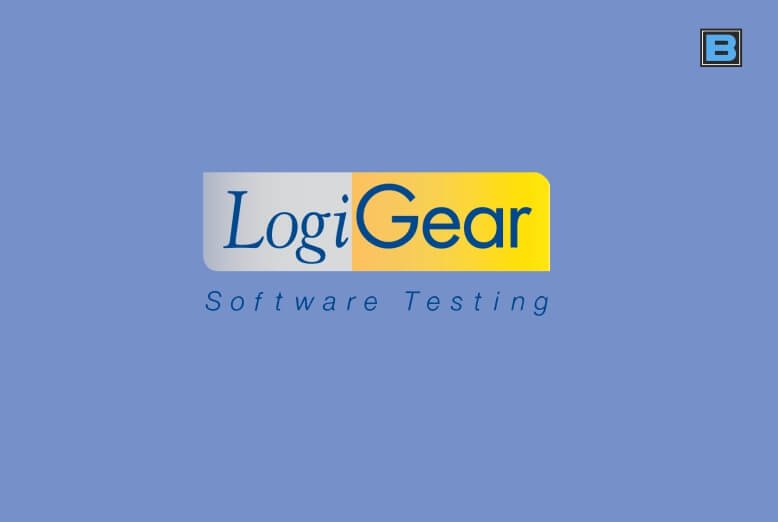
Software testing company, LogiGear opens APAC office, announces new CEO
Recommended:.

Navigating March Madness and Beyond on Melbet
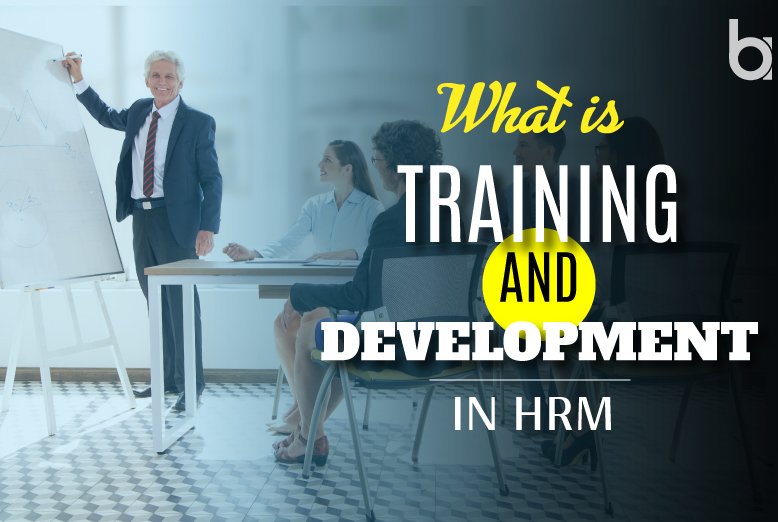
What is Training and Development in HRM [Updated 2024]

Five Effective Care Measures for Preventing Pressure Sores
Your business stories meet the right audience, start typing and press enter to search, quick links.
- Subscription
Company Info
- Privacy Policy
- Terms & Conditions
Our Services
- Advertise With Us
- Press Release

West has been driving the business world owing to its developed economies. The leading part of the world is straining to sustain its dominance. However, the other parts of the world, especially Asia Pacific region have been displaying escalating growth in terms of business and technological advancements.
- +91-7666256451
Copyright © 2022 - Business APAC. All Right Reserved.
Hire us to spread your content.
- Business Essentials
- Leadership & Management
- Credential of Leadership, Impact, and Management in Business (CLIMB)
- Entrepreneurship & Innovation
- *New* Digital Transformation
- Finance & Accounting
- Business in Society
- For Organizations
- Support Portal
- Media Coverage
- Founding Donors
- Leadership Team

- Harvard Business School →
- HBS Online →
- Business Insights →
Business Insights
Harvard Business School Online's Business Insights Blog provides the career insights you need to achieve your goals and gain confidence in your business skills.
- Career Development
- Communication
- Decision-Making
- Earning Your MBA
- Negotiation
- News & Events
- Productivity
- Staff Spotlight
- Student Profiles
- Work-Life Balance
- Alternative Investments
- Business Analytics
- Business Strategy
- Business and Climate Change
- Design Thinking and Innovation
- Digital Marketing Strategy
- Disruptive Strategy
- Economics for Managers
- Entrepreneurship Essentials
- Financial Accounting
- Global Business
- Launching Tech Ventures
- Leadership Principles
- Leadership, Ethics, and Corporate Accountability
- Leading with Finance
- Management Essentials
- Negotiation Mastery
- Organizational Leadership
- Power and Influence for Positive Impact
- Strategy Execution
- Sustainable Business Strategy
- Sustainable Investing
- Winning with Digital Platforms
How to Implement Organizational Change Successfully

- 16 Mar 2023
Change is inevitable in business. To remain viable, organizations must adapt to internal and external shifts.
Business leaders have a responsibility to be catalysts for positive organizational change. That change can’t occur without proper implementation.
To help you transition to a new leadership role, here's an overview of organizational change and how to implement it successfully.
Access your free e-book today.
What Is Organizational Change?
Organizational change involves altering one or more of a company’s major components, such as its culture, infrastructure, and internal processes. To guide your organization toward success, you must be proficient at navigating change.
Change can be difficult to manage. It can be predictable or unexpected and occur gradually or all at once.
“The reality is that companies won’t keep perfect pace with all the change that’s evolving in their industry, or in consumer needs and preferences, or in technological advances,” says Harvard Business School Professor Joshua Margolis in the online course Organizational Leadership . “That's why periodic leaps in how organizations function are required to catch up after lots of small contextual shifts accumulate.”
According to Organizational Leadership , you can categorize organizational change by its:
- Degree of difficulty: How difficult the change will be to implement within your organization, including how much effort it requires, how easy it'll be to modify existing practices, how simple it is to understand, and how much of your organization will be involved
- Nature of the upgrade: The type of upgrade needed to repair your organization’s broken components or pursue new opportunities
Within these categories, you can measure organizational change's magnitude using a spectrum from adaptive to transformational change.
- Adaptive changes are small, incremental, and occur gradually over an extended period.
- Transformational changes have a much larger impact and typically occur dramatically and suddenly rather than incrementally.

Most changes won’t be solely adaptive or transformational but instead occur between the two. To be an effective leader , it's vital to learn how to implement changes on both sides of the spectrum—and everywhere in between.
6 Steps to Implement Organizational Change
Organizational Leadership breaks the change implementation process into six steps, known as the CHANGE model.
- C onceptualize: Distill your organization’s complex issues into a clear picture of root causes and potential solutions.
- H ear: Gather perspectives from different team members to learn what you do and don't understand.
- A genda: Craft a plan based on the issues you identify and perspectives you gather that establishes the direction your organization should go and how to get there.
- N exus: Identify the features within each component of your organization’s architecture that will drive change.
- G uide and govern: Use yourself to implement change within your organization.
- E ngage and execute: Encourage others to participate in change implementation.
This model illustrates the various teams within your organization that must participate for change to be successful. To break this down even further, you can separate these steps into three groups.
Conceptualize and Hear
When compiling information, it's crucial to consider multiple perspectives.
“ Conceptualize and hear work in a paired cycle,” says HBS Professor Anthony Mayo in Organizational Leadership . “As you listen in hear, you refine your conceptualization of the challenges and opportunities facing the organization and the root causes.”
Avoid jumping to conclusions during this stage. It can be easy to judge a situation quickly based on initial observations, but doing so can cause you to overlook critical data.
Successful implementation requires gathering all relevant data, observing the internal and external environment, examining change’s potential impacts, and considering feedback.
Agenda and Nexus
Once you’ve thoroughly researched the situation, your next step is shifting from analysis to action. This requires a clear blueprint for how and where change is needed.
“ Agenda and nexus go together,” Margolis says in Organizational Leadership . “Nexus—meaning intersection—specifies where the change needs to occur within the organization and which architectural elements to start with to execute on the agenda.”
To succeed at this stage, ensure your agenda is compelling. If others in your organization don't understand or aren't excited about it, it'll be more difficult to implement.
Guide and Govern/Engage and Execute
The CHANGE model’s last two components are critical to putting your plan into action.
“ Guide and govern —together with engage and execute— are about implementation," Margolis says in Organizational Leadership . “How can leaders use themselves to mobilize people, communicate in all directions, review progress, and correct course?”

Since change often requires modifying how to accomplish tasks, implementation can be arduous. Effective communication is key to reducing resistance.
Here are four tips for communicating change to your team:
- Share a vision: Confirm your team knows how the change benefits them and the company.
- Tell a story: Get creative in how you communicate the change. Whether portraying it as a heroic tale or using graphics to convey its benefits, telling a story can help get employees on board.
- Make your team the heroes: Verify that others understand their role in the change so they feel like heroes rather than victims of it.
- Chart the path: Organizational change can be difficult, making it critical to ensure your team knows how it helps them and the organization over the long term.
In this stage, leading by example can be the difference between succeeding and failing.
“Leaders don’t just guide and govern change,” Margolis says in Organizational Leadership . “They themselves change as they lead their organizations.”
Be approachable and open to feedback. You should also set an example for others. When influencing others , actions speak louder than words.
Leading Successful Organizational Change
Depending on the change’s nature, strong internal resistance is likely. Your change initiative could be perceived as disruptive to your company’s culture or intimidating because it’s unfamiliar.
“Although familiar practices may have outlived their usefulness—or soon fail to work as well as they once did—those comfortable habits and reflexes remain because they’re how your company achieved success in the past,” Mayo says in Organizational Leadership .
The mentality of “it worked before, so it'll work now” can hinder innovation , which requires open-endedly exploring novel ideas. Overcoming that mindset requires intention.
“As a catalyst, you, the leader, must ignite change,” Margolis says in Organizational Leadership , “acting as the spark that inspires, encourages, enables, and reassures your team so that they can adapt in both small and large ways to deliver value continuously.”

Preparing to Lead Your Team to Success
If you're ready to improve your leadership skills , taking a training course , such as Organizational Leadership , can enable you to reap several benefits and gain the skills to lead and implement change.
Whether you’re already a leader or working toward becoming one, a leadership certificate course can help you develop your professional network , communicate effectively, and build a strong corporate culture.
While change is inevitable, you can successfully navigate it with the right skill set.
Are you ready to develop the skills to implement change? Enroll in Organizational Leadership —one of our online leadership and management courses —and discover how to lead your company to long-term success. To learn more about what it takes to be an effective leader, download our free leadership e-book .

About the Author

Adaptive Change Management: A Comprehensive Guide for Leaders

Imagine a world where organizations effortlessly adapt to shifting market conditions, seize opportunities, and thrive in the face of adversity.
Sounds too good to be true?
Well, this could be your organization’s reality with the help of adaptive change management. In this blog post, we will explore the intricacies of adaptive change, the crucial role of adaptive change leaders , and how to implement this powerful strategy in your organization.
As the business environment becomes increasingly unpredictable, adaptive change management has emerged as a vital tool for organizations to stay competitive and resilient.
Are you ready to embark on this exciting journey?
Let’s dive in and unlock the full potential of your organization through adaptive change management.
Short Summary
- Adaptive change management is a flexible approach to managing organisational change. Adaptive change is essential for businesses to stay competitive and successful.
- Adaptive leaders play a crucial role in managing change. Leaders need skills to balance perspectives, manage conflict & resistance, engage stakeholders and develop plans when implementing adaptive change management.
- Real life examples demonstrate how adaptive change can help organizations become agile, responsive & innovative.
Understanding Adaptive Change

Now, you might wonder how adaptive change differs from its counterpart, technical change. While both are essential for organizational success, they have distinct characteristics that set them apart.
Let’s explore these differences in the next section and understand their unique roles in driving change initiatives.
The Importance of Adaptive Change
Adaptive change enables organizations to tackle complex challenges, foster innovation, and stay ahead of the competition.
A well-executed change initiative can lead to significant improvements in organizational performance and resilience. However, implementing adaptive changes often requires navigating through uncertainty and addressing external threats.
On the other hand, managing the stress of employees during a significant organizational change is a colossal challenge for leaders. Reducing resistance is crucial when implementing adaptive change, and it involves open communication, involving employees in decision-making, and fostering a growth mindset.
Effective conflict management also plays a key role in the success of adaptive change initiatives.
Adaptive vs. Technical Change
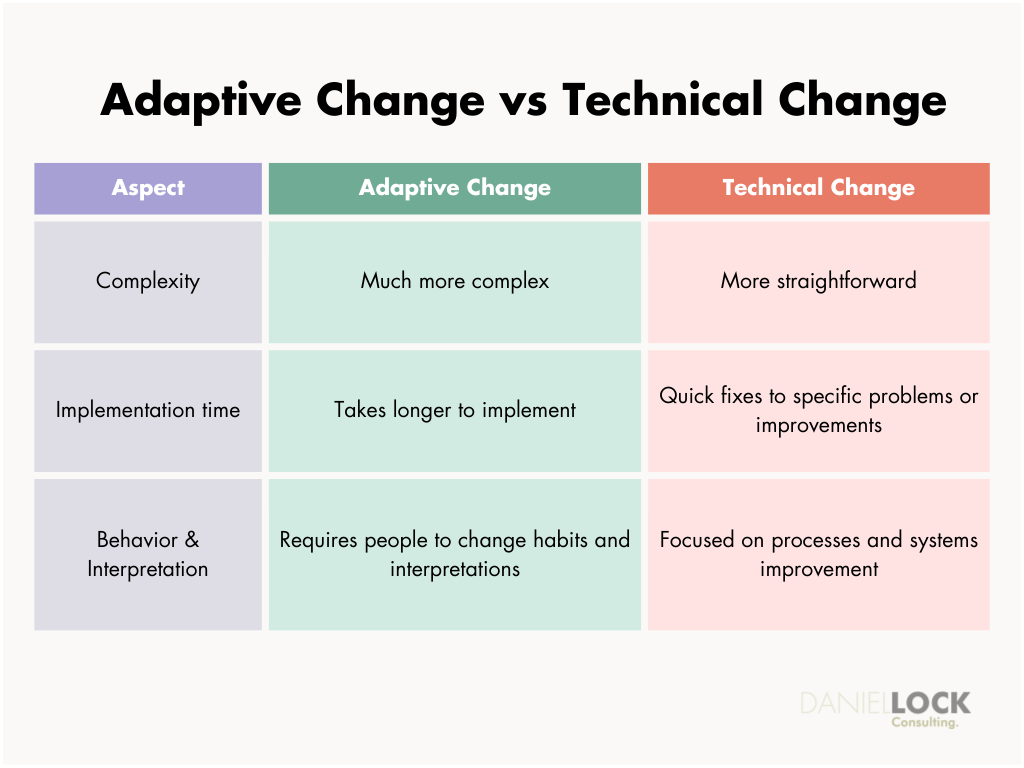
While adaptive and technical change are essential components of organizational development, they differ in several aspects. Adaptive change is more complex, takes longer to implement, and requires people to change their habits and interpretations.
On the other hand, technical change is more straightforward, involving quick fixes to specific problems or improvements to existing processes .
Understanding the contrast between adaptive and technical change can help leaders come up with more efficient solutions and drive change initiatives strategically.
For instance, a power outage at a waste management facility would be a technical change, while a shift in company culture to embrace diversity and inclusion would be an adaptive change.
Now that we have a grasp of adaptive change, let’s delve into the role of adaptive leaders in managing such change.

The Adaptive Leader

Leading adaptive change is no easy feat. It takes a special kind of individual to embrace the challenges of leadership and make a positive impact on the lives of others.
Adaptive leaders must possess a unique blend of intellectual, physical, and emotional capabilities to drive organizational development and successfully navigate through the complexities of change.
A crucial aspect of adaptive leadership is the ability to balance perspectives, maintaining a bird’s-eye view of the situation while still being involved in the action. This skill enables leaders to spot patterns and tackle problems more effectively, ensuring a smooth transition during the change process.
Let’s explore how adaptive leaders can strike this balance and manage conflict and resistance in the next sections.
Balancing Perspectives
Having a balanced perspective is essential for adaptive leaders, allowing them to:
- Maintain an overall view of the situation
- Be involved in the action
- Spot patterns
- Tackle problems more effectively
- Ensure a smooth transition during the change process.
So, how can leaders strike this balance?
Taking a break to look at the situation from a wider perspective can help leaders spot patterns and potential solutions that they may have missed if they were too focused on the action.
This different approach enables them to identify common themes or trends in the data and come up with strategies for resolving issues, ultimately leading to a more successful change initiative.
Managing Conflict and Resistance
During the adaptive change process , leaders may encounter resistance and conflict from employees and stakeholders. Addressing these issues is crucial for the success of the change initiative.
Adaptive leaders can overcome resistance by providing clear communication, addressing concerns promptly, and involving stakeholders in dialogue.
By fostering open communication and focusing on solutions instead of assigning blame, adaptive leaders can address conflicts constructively and help stakeholders see the benefits of change.
In doing so, they create a supportive environment where employees and stakeholders can collaborate and contribute to the success of the change initiative.
Implementing Adaptive Change Management
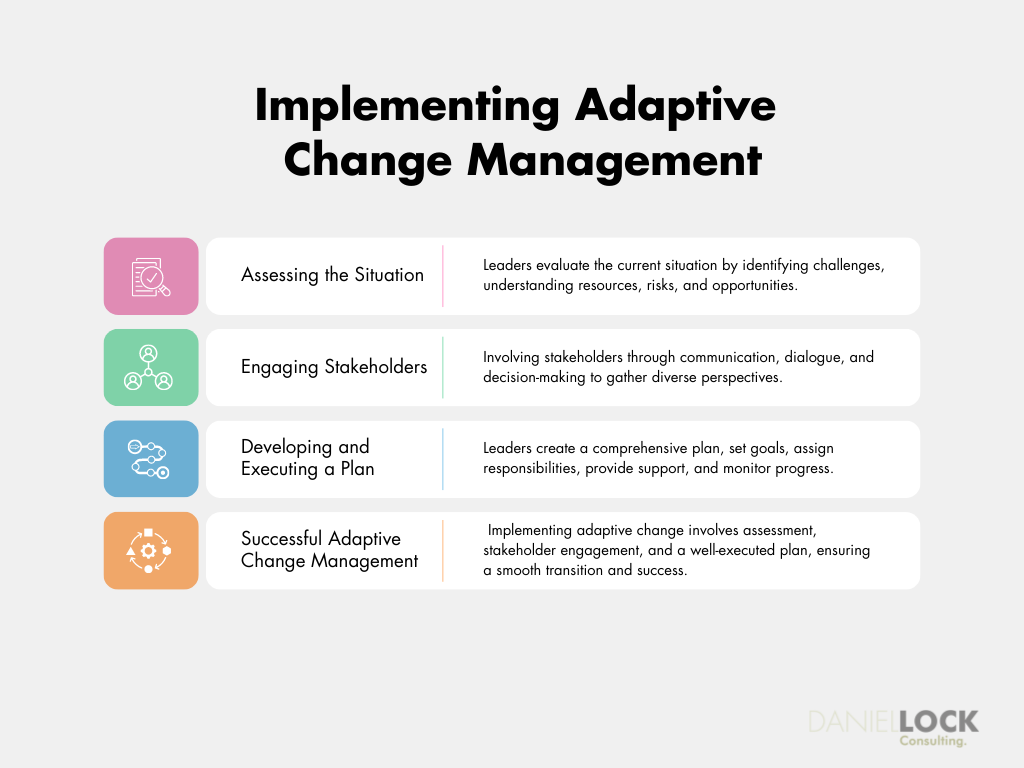
To successfully implement adaptive change management, leaders need to follow a structured process, based on principles , that involves assessing the current situation, engaging stakeholders, and developing and executing a plan.
This process ensures that the organization is well-prepared for the change and that the transition is as smooth as possible.
Involving all relevant stakeholders in the change process is crucial for the success of adaptive change management.
By engaging stakeholders, leaders create a more comprehensive understanding of the change process and ensure that all relevant perspectives are considered.
In the next sections, we will explore the steps involved in implementing adaptive change management in more detail.
Assessing the Situation
Evaluating the current situation is the first step in implementing adaptive change management. Leaders must:
- Identify the challenges their organization faces
- Determine the need for adaptive change
- Understand the given situation
- Assess the resources available
- Identify potential risks
- Identify opportunities for improvement
By thoroughly assessing the situation, leaders can develop a clear understanding of the challenges their organization faces and the changes that need to be made to address these challenges.
This information can then be used to create a comprehensive plan for implementing adaptive change, ensuring that the organization is well-prepared for the transition.
Engaging Stakeholders
Involving stakeholders in the change process is essential for the success of adaptive change management. Engaging stakeholders helps create a more comprehensive understanding of the change process and ensures that all relevant perspectives are considered.
This can be achieved by providing stakeholders with information, statistics , engaging in dialogue, and involving them in decision-making.
Creating a safe space for honest conversations and collaboration is also crucial for engaging stakeholders and overcoming resistance. By fostering trust and encouraging commitment to the change process, leaders can ensure that the transition is smooth and that the organization is well-prepared for the challenges ahead.
Developing and Executing a Plan
With a clear understanding of the challenges and the need for adaptive change, leaders must create a comprehensive plan for implementing adaptive change in their organization. This plan should include setting goals, assigning responsibilities, and monitoring progress.
Executing the plan involves providing the necessary support, resources, and guidance to ensure the change is successful. By rolling out the change execution with a support plan in place and offering engagement sessions and training, leaders can help everyone adopt the change and contribute to its success.
Overcoming Common Challenges in Adaptive Change Management
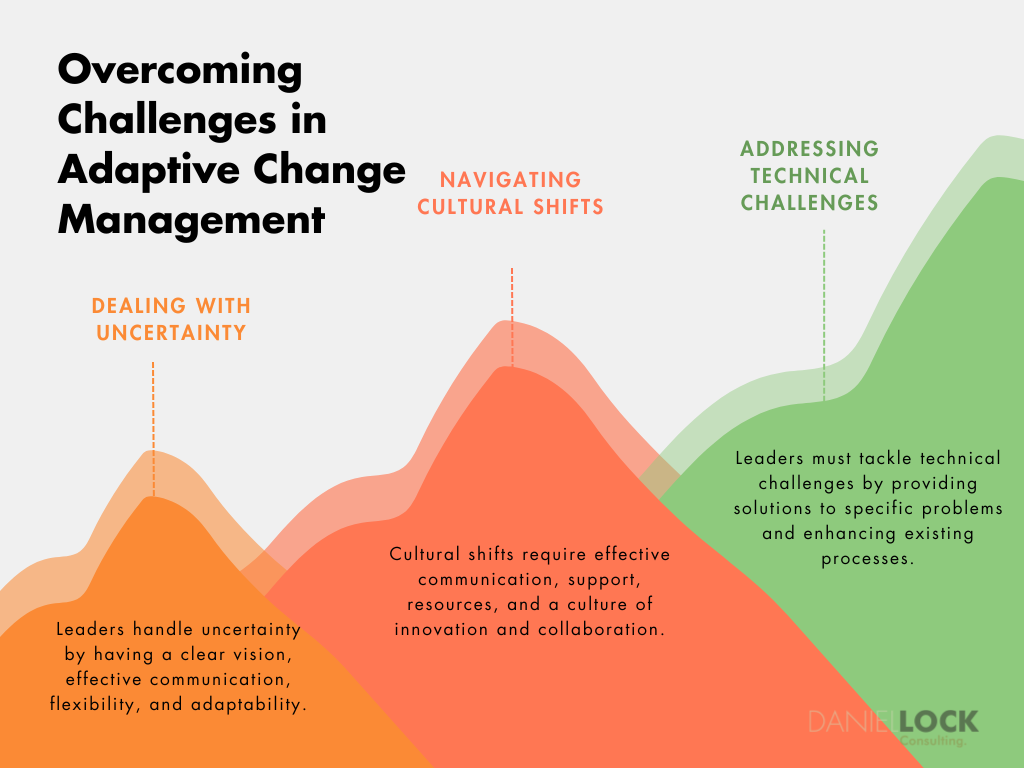
Adaptive change management is not without its challenges. Leaders often face obstacles such as taking ownership of the changes, challenging the status quo, and understanding the difference between technical and adaptive challenges.
To overcome these challenges, leaders must create a shared vision, involve stakeholders, and foster trust.
In the next sections, we will discuss strategies for dealing with two common challenges in adaptive change management: uncertainty and navigating cultural shifts, as well as addressing technical challenges.
Dealing with Uncertainty
Uncertainty is an inherent aspect of adaptive change, as the process often involves making decisions based on evolving circumstances. To deal with uncertainty, leaders must have a clear vision and plan, communicate effectively, and be flexible and open to change.
Creating contingency plans, keeping an eye on changes in the environment, and staying open to new ideas and approaches can help leaders navigate the uncertainty of adaptive change.
By being prepared to adapt and make decisions based on changing circumstances, leaders can ensure their organization remains competitive and successful.
Related : 10 Best AI Tools for Change Management
Navigating Cultural Shifts
Implementing adaptive change may require significant cultural shifts within the organization. Leaders must effectively communicate the need for change and support employees through the transition.
Fostering a growth mindset and a learning culture is crucial for employees to be open to new ideas and embrace change.
Providing employees with the necessary resources, guidance, and a supportive work environment can help them adjust to the changes and improve their performance.
By cultivating a culture of innovation and collaboration, leaders can ensure that their organization successfully adapts to the changing business environment.
Real-Life Examples of Adaptive Change
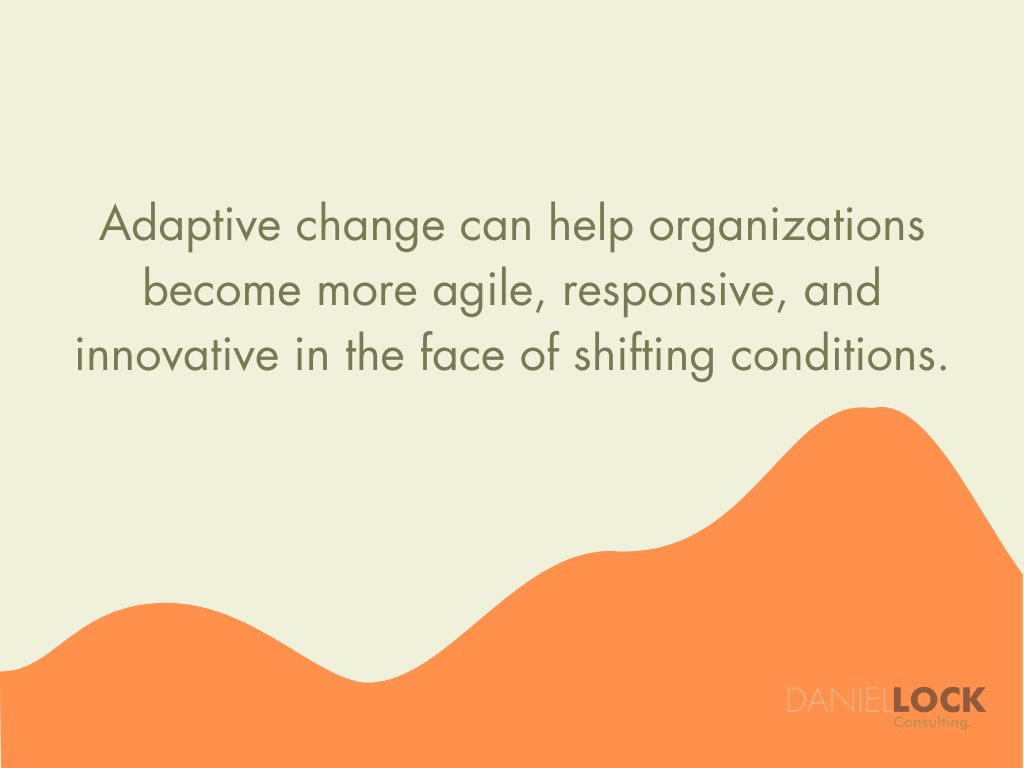
Now that we have a solid understanding of adaptive change and how it can be implemented, let’s take a look at some real-life examples that demonstrate the impact of adaptive change on organizations.
These examples highlight how adaptive change can help organizations become more agile, responsive, and innovative in the face of shifting conditions.
Whether it’s resolving interpersonal conflicts in the workplace, adjusting to a new manager, or following the footsteps of visionary leaders like Abraham Lincoln who embraced diversity and change, adaptive change can have a profound effect on organizational success and pave the way for a promising future.
Let’s explore two specific examples of adaptive change in action.
Adaptive change management is a crucial concept in today’s fast-paced and ever-evolving business environment. Here are two case studies that exemplify the definition you provided:
Netflix’s Evolution from DVD Rentals to Streaming :

Background : Netflix started as a mail-order DVD rental service in 1997. By the mid-2000s, they had a successful business model based on mailing DVDs to subscribers.
Adaptive Change : As broadband internet became more widespread, Netflix recognized the potential of streaming media. Instead of sticking to their original model, they began investing heavily in streaming technology and content.
This was a significant shift and required the company to adapt to new technologies, customer behaviors, and market conditions.
Outcome : Today, Netflix is a global streaming giant with original content in multiple languages. Their ability to foresee the shift in media consumption and adapt their business model accordingly is a classic example of adaptive change management.
LEGO’s Business Transformation :

Background : LEGO, the beloved toy brick company, faced near bankruptcy in the early 2000s. They had diversified too much into areas like theme parks, clothing, and video games, diluting their core brand.
Adaptive Change : Recognizing the need for change, LEGO embarked on a transformation journey. They refocused on their core product, the LEGO brick, and began engaging with their user community more actively.
They also started collaborating with franchises like Star Wars, Harry Potter, and Marvel, which resonated with both old and new fans.
Outcome : By the 2010s, LEGO had not only recovered but was thriving.
Their adaptive approach to change, which involved both returning to their roots and innovating in ways that resonated with their audience, saved the company.
Both of these case studies highlight the importance of recognizing changing conditions and being flexible in response.
They also emphasize that adaptive change management is not just about reacting to external changes but also about understanding one’s core strengths and leveraging them in new and innovative ways.
As a result of implementing adaptive change, the company saw improvements in employee performance. The new workflows increased collaboration, and the additional resources and support empowered employees to perform at their best.
This example highlights the potential of adaptive change to drive positive outcomes in organizations.
Building the Skills for Adaptive Change Management

Developing the necessary skills for adaptive change management is crucial for leaders to successfully handle organizational change. Managers need strong skills in:
- Communication
- Problem-solving
- Decision-making
- Conflict resolution
Experience and on-the-job training alone are not sufficient to effectively manage change, as they may eventually fail to address unforeseen challenges.
To build these skills, leaders can invest in management training courses, programs, and workshops. By honing their adaptive change management skills, leaders will be better equipped to navigate the complex challenges of organizational change and drive their organizations to new heights of success.
In conclusion, adaptive change management is a powerful tool that enables organizations to stay competitive and resilient in an ever-changing business environment.
By understanding the nuances of adaptive change, developing the necessary skills, and effectively implementing adaptive change initiatives, leaders can drive their organizations to new heights of success.
So, are you ready to embrace adaptive change and unlock your organization’s full potential?
Frequently Asked Questions
What is the goal of adaptive change.
The goal of adaptive change is to help organizations survive and prosper in an ever-evolving environment by introducing permanent changes to their strategy, structure, and processes.
What are the 6 principles of adaptive work?
Adaptive Leadership is based on six key principles: focusing on the big picture, understanding context, enabling collaboration, learning and adapting, embracing experimentation, and making decisions.
These principles help leaders better understand the complexities of dynamic environments and foster a culture of successful problem solving.
What is the difference between transformational change and adaptive change?
Transformational change is a dramatic evolution of some basic structure of a business, whereas adaptive change happens incrementally over time. Transformational change is often sudden and drastic, while adaptive change are small, incremental changes that usually take place internally.
What are the 4 stages of adaptive leadership?
Adaptive leadership has four distinct stages: emotional intelligence, organisational justice, development and character. All of these elements are essential for successful leadership.
What is the meaning of adaptive changes?
Adaptive change is the process of making small, incremental adjustments to adapt to daily, weekly, and monthly business challenges that require new learning and problem solving. It can involve experimenting with new approaches and practices to address complex and nebulous issues.
Leave a Comment
Save my name, email, and website in this browser for the next time I comment.
Please note: JavaScript is required to post comments.
Next post: The Value of Change Management
Previous post: Change Management vs Management of Change: Decoding the Jargon (And Why It Matters)
- Change Leadership: Understanding What Is and Its Impact on Organizations
- Why is Change Management Important: Key Advantages for Modern Businesses
- Becoming a Change Leader: How to Become a Change Manager and Propel Your Career
- The Antecedent-Behavior-Consequence (ABC) Model in Reinforcement Systems: A Deep Dive into Change Management
- Best Change Management Tools and Software

How To Create a Business Plan for Adaptive Clothing Line: Checklist
By alex ryzhkov, resources on adaptive clothing line.
- Financial Model
- Business Plan
- Value Proposition
- One-Page Business Plan
- SWOT Analysis
- Business Model
- Marketing Plan
Welcome to our blog post on how to write a business plan for an adaptive clothing line! In today's dynamic business landscape, it's crucial to stay ahead of the curve by offering innovative products that cater to niche markets. With the fashion industry embracing inclusivity and diversity like never before, there is a growing demand for clothing that addresses the unique needs of individuals with physical disabilities or mobility challenges.
The adaptive clothing industry has witnessed remarkable growth in recent years, with a projected market value of $400 million by 2026 . This exponential growth is a testament to the increasing awareness and acceptance of adaptive fashion as an essential part of the overall well-being of individuals with disabilities.
Now, let's dive into the nine steps you need to follow to create an effective business plan for your adaptive clothing line. Starting with market research and identifying your target audience, you'll explore everything from competitor analysis and brand positioning to pricing strategies and distribution channels. Additionally, conducting a feasibility study and assessing financial projections will provide a solid foundation for your venture. Finally, we'll guide you through the process of defining your organizational structure, creating key roles, and developing a comprehensive marketing and promotional plan.
With this step-by-step checklist, you'll have all the tools you need to bring your vision of an adaptive clothing line to life. So, let's get started on building a business plan that combines fashion, functionality, and inclusivity to make a positive impact on the lives of individuals with physical disabilities or mobility challenges.
Research The Market And Identify The Target Audience
Before starting any business venture, it is essential to thoroughly research the market and identify the target audience . This step lays the foundation for a successful business plan and enables you to understand the needs, preferences, and buying behaviors of your potential customers.
Begin by conducting market research to gain insights into the demand for adaptive clothing within your target market. Look for data and statistics related to the size and growth potential of the industry, as well as any trends or developments that may impact the market in the near future. This information will help you assess the market's viability and make informed decisions regarding your business strategies.
Once you have a clear understanding of the market, it's time to identify your target audience . Determine the specific demographic, psychographic, and behavioral characteristics of the individuals who will benefit most from your adaptive clothing line. Consider factors such as age, gender, income level, lifestyle, and personal preferences. This will help you tailor your products, marketing messages, and overall brand image to resonate with your target audience.
Tips for researching the market and identifying the target audience:
- Utilize online resources, industry reports, and market research firms to gather comprehensive data about the adaptive clothing market.
- Engage with healthcare professionals, physical therapists, and individuals with physical disabilities to gain firsthand insights and understand their needs.
- Conduct surveys, focus groups, or interviews to collect valuable feedback and preferences from your target audience.
- Stay updated on the latest fashion and health trends to identify opportunities for innovation and market differentiation.
- Seek partnerships or collaborations with organizations or influencers within the disability community to enhance your brand's visibility and credibility.
By thorough market research and identifying your target audience, you can develop a business plan that aligns with customer demands and effectively positions your adaptive clothing line in the market.
Identify The Unique Selling Proposition (USP) Of The Adaptive Clothing Line
The Unique Selling Proposition (USP) of our Adaptive Clothing Line is the seamless integration of fashion and health, catering specifically to individuals with physical disabilities or mobility challenges. Our clothing designs are not only stylish but also incorporate innovative features that promote independence, ease of use, and comfort.
- Research and understand the needs of individuals with physical disabilities or mobility challenges to identify gaps in the market.
- Consider the current options available in the market and find ways to differentiate our clothing line by offering unique features and solutions.
- Collaborate with healthcare professionals, occupational therapists, and individuals with disabilities to gain insights into the challenges they face while dressing and find opportunities for innovative design solutions.
- Create a range of stylish and trendy designs that are adaptive, incorporating features such as easy-to-use fastenings, adjustable components, and specialized fabric technology.
- Prioritize comfort, fit, and functionality, ensuring that the clothing line meets the specific requirements and preferences of our target audience.
- Emphasize the importance of inclusivity and empowerment, enabling individuals to express their personal style while overcoming the limitations imposed by traditional clothing options.
Tips for Identifying the Unique Selling Proposition of Your Adaptive Clothing Line:
- Conduct thorough market research to understand the needs and preferences of individuals with disabilities and mobility challenges.
- Identify gaps in the market and potential areas for innovation.
- Collaborate with healthcare professionals and individuals with disabilities to gain insights and feedback on your clothing designs.
- Focus on creating adaptive features and solutions that prioritize functionality, comfort, and style.
- Highlight the empowering nature of your clothing line, enabling individuals to express their personal style and improve their overall well-being.
Conduct A Competitor Analysis.
Conducting a competitor analysis is crucial in understanding the competitive landscape and identifying opportunities for your adaptive clothing line. By analyzing your competitors, you can gain insight into their strengths, weaknesses, and overall market positioning. This analysis will enable you to differentiate your business and develop strategies to effectively capture your target audience.
Start by identifying your direct competitors. These are companies that offer similar products or services to your adaptive clothing line. Research their product offerings, pricing, and target audience. Look for any unique features or customer benefits they provide.
Next, evaluate your competitors' marketing strategies. Examine their online presence, social media channels, and advertising campaigns. By understanding their messaging and communication tactics, you can identify gaps and opportunities to position your adaptive clothing line.
Analyze the strengths and weaknesses of your competitors. Look at factors such as their brand reputation, customer reviews, and customer service. Identify areas where your adaptive clothing line can excel and offer a superior experience for your target audience.
Tips for conducting a competitor analysis:
- Make a list of your top competitors and regularly monitor their activities.
- Utilize online tools and resources to gather information about your competitors.
- Consider conducting surveys or interviews with your target audience to understand their perception of your competitors.
- Analyze pricing strategies and identify opportunities to offer competitive pricing or added value.
- Identify any gaps or untapped niche markets that your competitors may have overlooked.
By conducting a thorough competitor analysis, you can gain valuable insights that will inform your business strategy and help you position your adaptive clothing line effectively in the market. Continuously monitor and adapt your analysis as the industry evolves to stay ahead of your competitors and deliver a compelling offering to your target audience.
Define The Brand Positioning And Create A Brand Identity
Defining the brand positioning and creating a strong brand identity are crucial steps in establishing the Adaptive Clothing Line as a unique and recognizable brand in the market. Brand positioning involves identifying the specific market segment your clothing line will cater to and determining how you want your brand to be perceived by your target audience.
To define your brand positioning, consider the following:
- Your target audience: Who are the individuals with physical disabilities or mobility challenges that your clothing line will serve? What are their needs, preferences, and aspirations?
- Unique selling proposition: What makes your adaptive clothing line stand out from competitors? What key features or benefits set your brand apart?
- Brand personality and values: What do you want your brand to represent? Are you aiming for a more professional and sophisticated image, or a trendy and vibrant persona?
- Brand promise: What can customers expect when they choose your clothing line? How will your adaptive designs enhance their overall well-being and improve their quality of life?
Tips for creating a strong brand identity:
- Develop a unique brand name and logo that reflect the essence of your adaptive clothing line.
- Design a visually appealing and user-friendly website to showcase your products and engage with customers.
- Create consistent and compelling brand messaging across various marketing channels, including social media platforms, print materials, and promotional materials.
- Consider partnering with influencers or ambassadors who align with your brand values and can help spread the word about your clothing line.
- Utilize storytelling techniques to communicate the passion and inspiration behind your adaptive clothing line.
By defining your brand positioning and creating a strong brand identity, you will establish a clear and compelling image for the Adaptive Clothing Line, making it easier to attract and connect with your target audience.
Develop A Pricing Strategy
When it comes to developing a pricing strategy for your adaptive clothing line, it is crucial to consider various factors that will contribute to the overall success of your business. Pricing plays a significant role in determining your profitability and positioning in the market. Here are some important steps to consider when developing your pricing strategy:
- 1. Research the market: Begin by thoroughly researching the current market trends and pricing strategies adopted by your competitors. This will provide valuable insights into the acceptable price range for your products and help you identify any gaps in the market that you can capitalize on.
- 2. Consider production costs: Take into account the costs involved in designing, manufacturing, and sourcing materials for your adaptive clothing line. Calculating the accurate production costs will help you determine the minimum price required to cover your expenses and ensure profitability.
- 3. Evaluate your unique selling proposition (USP): Assess the value and uniqueness of your adaptive clothing line. Consider factors like the quality, functionality, and innovation incorporated into your designs. A strong USP can justify a higher price point for your products.
- 4. Factor in target audience affordability: Understand the financial capabilities and spending behavior of your target audience. Take into account their willingness to pay for inclusive and functional clothing. Balancing affordability with the value provided by your products is essential.
- Clearly communicate the value proposition of your products to justify premium pricing.
- Consider offering different pricing tiers to cater to a wider range of customers.
- Regularly reassess and adjust your prices based on market demand and customer feedback.
- 5. Analyze the perceived value: Assess how your target audience perceives the value of your adaptive clothing line. Understand the emotional benefits and positive impact your products bring to customers' lives. This will help you determine the optimal price that customers are willing to pay for your offerings.
- 6. Consider competitive positioning: Evaluate your positioning in relation to your competitors' pricing. Decide whether you want to position your adaptive clothing line as a premium, mid-range, or budget option. Consider the perceived value, quality of materials, and functionality when determining your price point.
- 7. Test and iterate: Start with an initial pricing strategy, but be open to testing different pricing models to find the optimal balance between profitability and customer demand. Monitor customer behavior and adapt your strategy accordingly to maximize sales and customer satisfaction.
Developing a pricing strategy for your adaptive clothing line requires careful consideration of market dynamics, production costs, and customer preferences. By strategically determining your pricing, you can ensure financial viability while offering unique and inclusive clothing options to individuals with physical disabilities or mobility challenges.
Determine The Distribution Channels For The Products
Once you have a clear understanding of your target audience and have defined your unique selling proposition, it's time to determine the distribution channels for your adaptive clothing line. This step is crucial in ensuring that your products reach your customers effectively and efficiently.
1. Direct Sales: Consider selling your products directly to customers through various channels, such as a physical store, an e-commerce website, or through social media platforms. Direct sales allow you to have complete control over the customer experience and build a direct relationship with your customers.
- Create an easy-to-navigate and visually appealing e-commerce website for online sales.
- Utilize social media platforms to showcase your products and engage with potential customers.
2. Retail Partnerships: Explore partnerships with retail stores that align with your brand values and target audience. This can be done by establishing wholesale agreements or consignment arrangements, allowing your products to be sold in their physical stores or online platforms.
- Research and identify retailers that cater to individuals with disabilities or have inclusive fashion lines.
- Prepare an attractive product catalog and present your brand story to potential retail partners.
3. Online Marketplaces: Consider expanding your distribution channels by listing your products on popular online marketplaces such as Amazon, eBay, or Etsy, which have a vast customer base. This can help increase your brand visibility and reach a wider audience.
- Optimize your product listings with clear and descriptive information, high-quality images, and customer reviews.
- Regularly monitor and update your listings to maintain a competitive edge.
4. Collaborations and Partnerships: Consider collaborating with organizations, influencers, or healthcare professionals who have a strong presence in the disability community. Partnering with individuals or organizations that share your values can help expand your reach and attract new customers.
- Identify potential collaborators who can help amplify your brand message and reach your target audience.
- Create mutually beneficial partnerships that promote inclusivity and raise awareness about your adaptive clothing line.
Remember, the key is to choose distribution channels that align with your brand values, target audience preferences, and business goals. Regularly reassess and adapt your distribution strategy as your business grows and new opportunities arise.
Conduct A Feasibility Study And Assess Financial Projections.
In order to ensure the viability and sustainability of your adaptive clothing line, it is crucial to conduct a thorough feasibility study and assess the financial projections. This will help you make informed decisions about the financial aspects of your business and determine whether your venture is economically feasible.
During the feasibility study, you will need to carefully analyze various factors such as the market demand for adaptive clothing, production costs, pricing strategies, potential sales volume, and projected revenue. This comprehensive assessment will provide you with a clearer understanding of the financial implications and potential profitability of your business.
Here are some key steps to consider during the feasibility study and assessment of financial projections:
1. Estimate Start-up Costs:
- Calculate the costs involved in setting up your adaptive clothing line, including expenses such as manufacturing equipment, inventory, website development, marketing, and branding.
- Consider any additional costs that may arise during the initial stages of business operations.
2. Research Production Costs:
- Identify the costs associated with designing, manufacturing, and sourcing the adaptive clothing.
- Research the prices of raw materials, specialized fabric technology, and any unique features incorporated in the designs.
- Estimate the costs of labor and production processes, including any outsourcing or collaborations with manufacturers.
3. Analyze Pricing Strategy:
- Determine the appropriate pricing strategy for your adaptive clothing line, considering factors such as production costs, competitor prices, target audience affordability, and perceived value of your products.
- Consider offering different price tiers or discounts for loyal customers or bulk orders.
4. Project Sales Volume:
- Research the market demand for adaptive clothing, considering factors such as the size of your target audience, their purchasing power, and the current trends in the fashion and health industries.
- Estimate the potential sales volume based on market research and customer feedback.
5. Create Financial Projections:
- Compile all the gathered data and estimates to create financial projections for your adaptive clothing line.
- Develop a comprehensive financial plan that includes projected revenue, expenses, and profit margins for at least the first few years of operation.
- Consider consulting with a financial advisor or accountant to ensure the accuracy and reliability of your projections.
By conducting a feasibility study and assessing financial projections, you will gain valuable insights into the financial viability and potential success of your adaptive clothing line. This information will guide your decision-making process and help you develop a sound financial strategy to support your business goals.
Decide On The Organizational Structure And Key Roles Needed
When starting a business, one crucial step is to decide on the organizational structure and key roles needed for the success of your adaptive clothing line. This step involves identifying the necessary positions and defining the responsibilities and skills required for each role.
Firstly, consider the core functions required for your business to operate smoothly. These may include areas such as design, production, marketing, sales, and finance. Assess the specific tasks and expertise needed in each area and determine the key roles that will fulfill those requirements.
To ensure a well-rounded team, it is important to include individuals with diverse backgrounds and skill sets. For example, you might need a fashion designer with experience in adaptive clothing design, a production manager with knowledge of specialized fabric technology, and a marketing specialist familiar with reaching the target audience.
Here are some key roles that you may want to consider for your adaptive clothing line:
- Founder/CEO: Provides overall vision, strategic direction, and leadership for the business.
- Designer: Creates innovative and inclusive clothing designs in collaboration with healthcare professionals.
- Production Manager: Oversees the manufacturing process and ensures the quality and timely delivery of products.
- Marketing Specialist: Develops marketing strategies, promotes the brand, and reaches the target audience effectively.
- Sales Manager: Establishes partnerships, manages sales channels, and ensures customer satisfaction.
- Finance Manager: Handles financial planning, budgeting, and ensures the financial health of the business.
- Consider the possibility of starting with a small team and gradually expanding as your business grows.
- Clearly define the roles, responsibilities, and reporting structure to avoid confusion and streamline operations.
- Identify any necessary external resources, such as consultants or advisors, who can provide specialized expertise.
- Regularly assess the performance and effectiveness of your team to identify any gaps or areas for improvement.
By carefully deciding on the organizational structure and key roles needed , you can ensure that your adaptive clothing line operates efficiently and effectively, bringing your vision to life and making a positive impact on the lives of individuals with physical disabilities or mobility challenges.
Create A Marketing And Promotional Plan.
Once you have developed your adaptive clothing line and defined your brand, it is crucial to create a comprehensive marketing and promotional plan to effectively reach your target audience and generate awareness about your unique products. The following steps will guide you in crafting an effective plan:
- Identify your target audience: Clearly define the demographics and characteristics of your ideal customers. Understand their needs, preferences, and purchase behaviors to tailor your marketing efforts accordingly.
- Define your marketing objectives: Determine the specific goals you want to achieve through your marketing activities. Whether it is increasing brand awareness, driving website traffic, or boosting sales, set measurable objectives to track your progress.
- Research and select marketing channels: Explore various marketing channels where you can reach your target audience effectively. This can include social media platforms, online advertising, influencer marketing, search engine optimization, email marketing, and more.
- Create compelling content: Develop engaging and informative content that showcases the unique features, benefits, and stories behind your adaptive clothing line. Utilize imagery, videos, and testimonials to effectively communicate the value proposition and generate interest.
- Utilize social media: Leverage the power of social media platforms to connect with your target audience, share updates, and engage with potential customers. Develop a content calendar and post regularly to maintain a consistent online presence.
- Collaborate with influencers: Identify influencers or advocates within the disability community who align with your brand values and target audience. Collaborate with them to promote your adaptive clothing line and expand your reach to their followers.
Tips for a successful marketing and promotional plan:
- Consider partnering with nonprofit organizations or charities focused on disabilities to further amplify your message and make a positive impact.
- Engage with your customers through interactive content, contests, or giveaways to encourage participation and create a sense of community around your brand.
- Regularly monitor and analyze marketing metrics to evaluate the effectiveness of your strategies and make necessary adjustments for continuous improvement.
- Stay updated on industry trends and adapt your marketing plan accordingly to stay ahead of the competition.
By creating a well-defined marketing and promotional plan, you can effectively communicate the unique value of your adaptive clothing line, connect with your target audience, and ultimately drive significant brand awareness and sales for your business.
In conclusion, writing a business plan for an adaptive clothing line requires careful research and strategic planning. By following the nine steps outlined in this checklist, entrepreneurs can effectively position their brand, understand the market, and create a comprehensive plan for success. With a strong business plan in place, the adaptive clothing line can demonstrate its unique selling proposition, identify its target audience, assess financial projections, and create a marketing strategy that promotes its innovative and inclusive products. By empowering individuals with physical disabilities or mobility challenges, the adaptive clothing line can make a positive impact on their lives and contribute to their overall well-being.

$169.00 $99.00 Get Template
Related Blogs
- Starting a Business
- KPI Metrics
- Running Expenses
- Startup Costs
- Pitch Deck Example
- Increasing Profitability
- Sales Strategy
- Rising Capital
- Valuing a Business
- How Much Makes
- Sell a Business
- Business Idea
- How To Avoid Mistakes
Leave a comment
Your email address will not be published. Required fields are marked *
Please note, comments must be approved before they are published
- SUGGESTED TOPICS
- The Magazine
- Newsletters
- Managing Yourself
- Managing Teams
- Work-life Balance
- The Big Idea
- Data & Visuals
- Reading Lists
- Case Selections
- HBR Learning
- Topic Feeds
- Account Settings
- Email Preferences
Onboarding New Employees — Without Overwhelming Them
- Julia Phelan

Give people the space and time they need to thrive in their new job.
A great onboarding experience can keep new hires engaged and committed, and increase their learning and preparedness for their new role. In trying to ensure new employees feel supported and properly prepared, some organizations flood new hires with far too much information. Even if managers have the best intentions, bombarding new hires with tasks — such as asking them to read every single page of the employee manual or requiring them to get set-up on Slack, email, Box, and all the other platforms all at once — will backfire. Three strategies can help organizations mitigate this overload and ensure employees have the space, time, and mental resources available to learn and thrive in their new job.
We know that effectively onboarding new employees has huge value. A good onboarding process — with clear information on job requirements, organizational norms, and performance expectations — not only enhances employee productivity but helps increase loyalty and engagement, and decrease s turnover .
- JP Julia Phelan , Ph.D. is a learning design consultant and expert in applying learning science principles to create effective learning experiences. She works with organizations to help build a strong workplace learning culture by improving training design, implementation, and outcomes. She is the co-founder of To Eleven , and a former UCLA education research scientist. Connect with her on LinkedIn .
Partner Center
Opposition raises concerns about Nova Scotia Health's missing business plans
Government gave health authority the ok not to produce a plan for 2022-23.

Social Sharing
NDP Leader Claudia Chender says there's a lack of public accountability at the provincial health authority after revealing the organization was given permission not to produce a business plan for 2022-23 and noting that no subsequent plans have been posted online.
During question period at the legislature on Thursday, Chender said an access to information request for the business plan generated a response saying Nova Scotia Health was given the OK not to produce the document.
The Health Authorities Act requires that the document be produced and submitted to the health minister each year and that it include annual operating expenses, coordination with community health boards and a public engagement plan.
Chender told reporters that not having a plan available for the public to see means people cannot gauge progress by Nova Scotia Health. No plan has been posted yet for 2023-24 or 2024-25, either.
"All we can do is hear the premier refute every negative question and then tell us that things are getting better when they clearly aren't," she said.
"The premier can say the sky is green, that doesn't make it true."
Health Minister Michelle Thompson said that as far as she knows, all legislative and policy requirements were met, despite the 2022-23 business plan not being produced.
Thompson said officials faced a lot of work related to the government's action for health plan at the time, as well as navigating the Omicron variant of COVID-19.
"I would say that '22-23 was a bit of an anomaly," she told reporters.
Thompson said she wasn't sure why the two most recent business plans have yet to be posted online, but that they have been submitted to her department and signed off on.
A spokesperson for Nova Scotia Health said a version of the 2022-23 business plan was not delivered to the minister until April of last year.
"[G]iven the timing in the business planning cycle, it was agreed that there was no longer a need for that year's plan to be finalized as work had turned to the next fiscal year," Jennifer Lewandowski said in a statement.
Lewandowski said the 2023-24 business plan should be published online within 30 days, but the 2024-25 plan is not yet finalized.
"July would be a good estimate of timing for this and you can contact us to obtain the link."
'It's not improving'
But Chender said it seems to be in the government's interest not to publish plans in a timely way, if at all. She noted that at a time when the government is making record spending on health care, it's not seeing the kind of results the public would hope for.
"Health care is getting precipitously worse. We have fewer people attached to primary care, we have emergency rooms closed more often; whatever the metric is, it's not improving."
Thompson said she's confident the health authority is operating in a transparent manner. Data about the health-care system is posted online and Thompson and other senior officials have travelled the province meeting with the public to answer questions, she said.
When the Tories formed government, they removed the health authority's board and fired the CEO, replacing him with a political appointee.
"We did say the day after we formed government that we, for a period of time, would have a health leadership team," said Thompson.
A system in transition
That team includes interim CEO Karen Oldfield, who has retained that tag since being appointed more than two years ago. Thompson said there are no plans at this point to change that designation.
"I would say that that position has not been made permanent and I would say, arguably, any of us in these roles currently are interim. I'm probably the interim health minister, if you look at it that way."
The system is in a time of transition and Thompson said what's important to her is that Oldfield is doing the work the government needs her to do "in order to move the health system forward."
"She's an important and competent member of the health team."
- Province shuts down plan for Antigonish amalgamation
- Nova Scotia government ends decades-long subsidy for disused Cape Breton rail line
- Video Mi'kmaq-led centre offers hands-on learning opportunities for all
- Video Her son has autism. She doesn't want others to have to pay thousands for support
ABOUT THE AUTHOR

Michael Gorman is a reporter in Nova Scotia whose coverage areas include Province House, rural communities, and health care. Contact him with story ideas at [email protected]

IMAGES
VIDEO
COMMENTS
The Secret of Adaptable Organizations Is Trust. by. Joerg Esser. March 15, 2021. Klaus Vedfelt/Getty Images. Summary. The pandemic has shone a sharp spotlight on the need for companies to be ...
An adaptable organisation will continually analyse and anticipate changes in its market to drive the evolution of its business. Using an adaptive mindset, these organisations place a great deal of value on situational awareness and invest in design and execution of digital and data initiatives to support the same.
The more an organization understands its customers, the closer it can get to achieving foresight and fluidity and becoming an adaptive organization. Ensuring that each interaction with a customer ...
Adaptive strategy execution is a sure-fire way of encouraging flexibility, close communication, and routine operational assessments, ensuring ongoing alignment with internal and external changes. Before looking at how you can embed this business adaptability framework into your organization, let's take a closer look at two of its core ...
Three Ways to Empower Bottom-Up Change. The participants pointed to three strategies for planting and nurturing the attributes of "adaptiveness" throughout any type of business or government agency. #1: Create Self-Directed Teams. The foundation of any bottom-up transformation starts with the empowerment of self-motivated, self-directed teams.
No. 1: Start execution as early as possible. Strategy defines the long-term choices and actions the enterprise must take to create, deliver and capture value as envisaged in the business model. But the more time spent creating a plan, the less time there is to execute it, increasing the risk that the world has moved on and the plan is out of date.
13. Become An Agent Of Change. The best way to ensure your business's adaptability to change is to become the agent of change in your industry. Use your strategy meetings to identify new ways to ...
achieving it shifts. In adaptive organizations, leaders are responsible for bringing the right employees Contemporary Leadership Practices Figure 1 Figure 2 Classical vs. Adaptive Organizations Classical Organization Design "plan and do" Define destination, develop strategy, and coordinate action Define direction, establish guardrails, and
An adaptive approach works when the business environment is hard to predict and to shape, and when advantage may be short-lived. Ongoing, substantial changes in technologies, customer needs, competitive offerings, or industry structure may all signal the need for an adaptive approach. Business environments increasingly require this mind-set ...
The choices a company makes in modulating variation, selection, and amplification are at the heart of adaptive strategy and its organizational implications. They affect organizational structure, governance, external relations, innovation, marketing strategy, and culture, to name but a few elements. The mechanisms of modulation are fundamentally ...
2 How to create an adaptive plan When creating an adaptive strategic plan, leaders balance the long and short view.They recognize that a vision of the organization's long-term destination acts as a north star to guide the team's decision making over time, while using near-term priorities to pull up on what is most important to achieve right now. ...
Making an Adaptive Strategic Plan. When creating an adaptive strategic plan, leaders balance the long and short view.They recognize that a vision of the organization's long-term destination is essential, acting as a north star to guide the team's decision making over time.. They pair that view with a few critical strategic priorities that the organization can pursue over the next 12 to 24 ...
An adaptive organization will not only be in a stronger position to rapidly respond to an ever-shifting internal and external environment, but leaders with an adaptive organizational design ...
Adaptive management is a systematic process for continually improving management policies and practices by learning from the outcomes of past operations. Here are a few more key components of the definition: It's a "learn by doing" approach, and may involve a high level of uncertainty. You have the ability to control the situation by making the ...
So, here are three key elements of an adaptive strategy. 1. Perception of Development. The first element of an adaptive strategy is the transparency of accomplishment. It is clear to understand how your plan is implemented concerning its original aims. And be ready to get answers to these questions fast enables you to evaluate well-informedly ...
5 Principles to Guide Adaptive Leadership. Summary. Responding to Covid-19 uncertainty requires adaptive leadership, which is defined as the ability to anticipate future needs, articulate those ...
Below are 4 Key Actions involved in building and executing a useful plan. Develop an adaptive business plan. The first step is the development of an adaptive business plan, containing 3-year and 5-year objectives, decomposed to 6-month goals and alternatives. That means every six months we can measure our performance and make adjustments if needed.
Business adaptation, or business model adaptation, is a set of decisions that relate to an organization's market strategy, organizational structure and transactions. These adaptive qualities provide organizations with the tools they need to navigate a variety of business challenges. Business adaptation and strategy experimentation can also help ...
6 Steps to Implement Organizational Change. Organizational Leadership breaks the change implementation process into six steps, known as the CHANGE model. C onceptualize: Distill your organization's complex issues into a clear picture of root causes and potential solutions. H ear: Gather perspectives from different team members to learn what ...
Adaptive change management is a flexible approach to managing organisational change. Adaptive change is essential for businesses to stay competitive and successful. Adaptive leaders play a crucial role in managing change. Leaders need skills to balance perspectives, manage conflict & resistance, engage stakeholders and develop plans when ...
The organizational planning process includes five phases that, ideally, form a cycle. Strategic, tactical, operational, and contingency planning fall within these five stages. 1. Develop the strategic plan. Steps in this initial stage include: Review your mission, vision, and values.
A Growth Strategy that Creates and Protects Value. by. David A. Hofmann. and. John J. Sumanth. April 01, 2024. Paloma Rincon Studio/Getty Images. Summary. For organizations to truly innovate and ...
Network with professionals in the adaptive clothing industry, such as designers, therapists, and organizations focused on disabilities, to gain a deeper understanding of the market. ... In conclusion, creating a business plan for an adaptive clothing retailer is essential for the success and sustainability of the venture. By following the steps ...
Decide On The Organizational Structure And Key Roles Needed. When starting a business, one crucial step is to decide on the organizational structure and key roles needed for the success of your adaptive clothing line. This step involves identifying the necessary positions and defining the responsibilities and skills required for each role.
A great onboarding experience can keep new hires engaged and committed, and increase their learning and preparedness for their new role. In trying to ensure new employees feel supported and ...
A spokesperson for Nova Scotia Health said the 2022-23 business plan was not delivered to the minister until April of last year. " [G]iven the timing in the business planning cycle, it was agreed ...